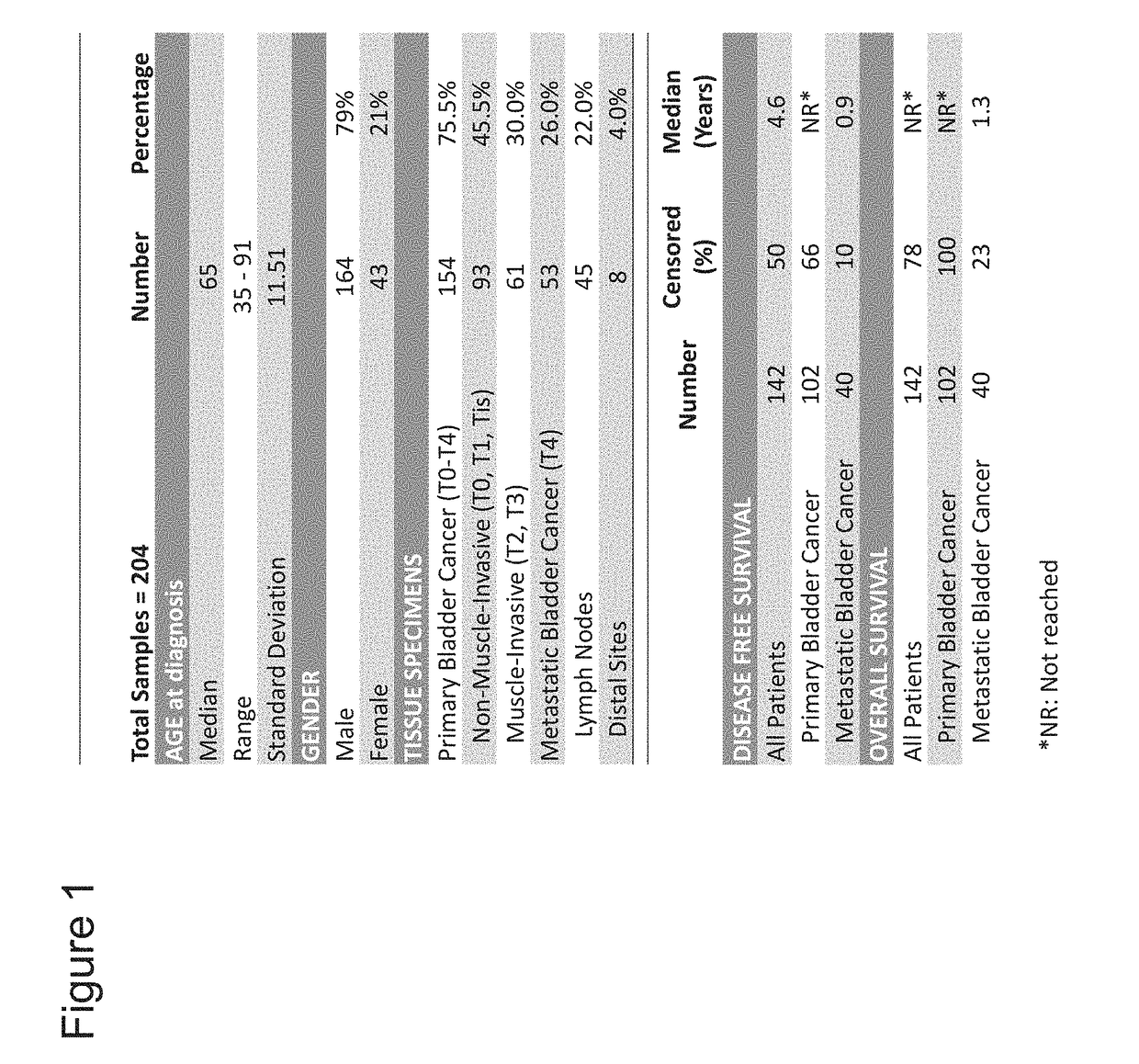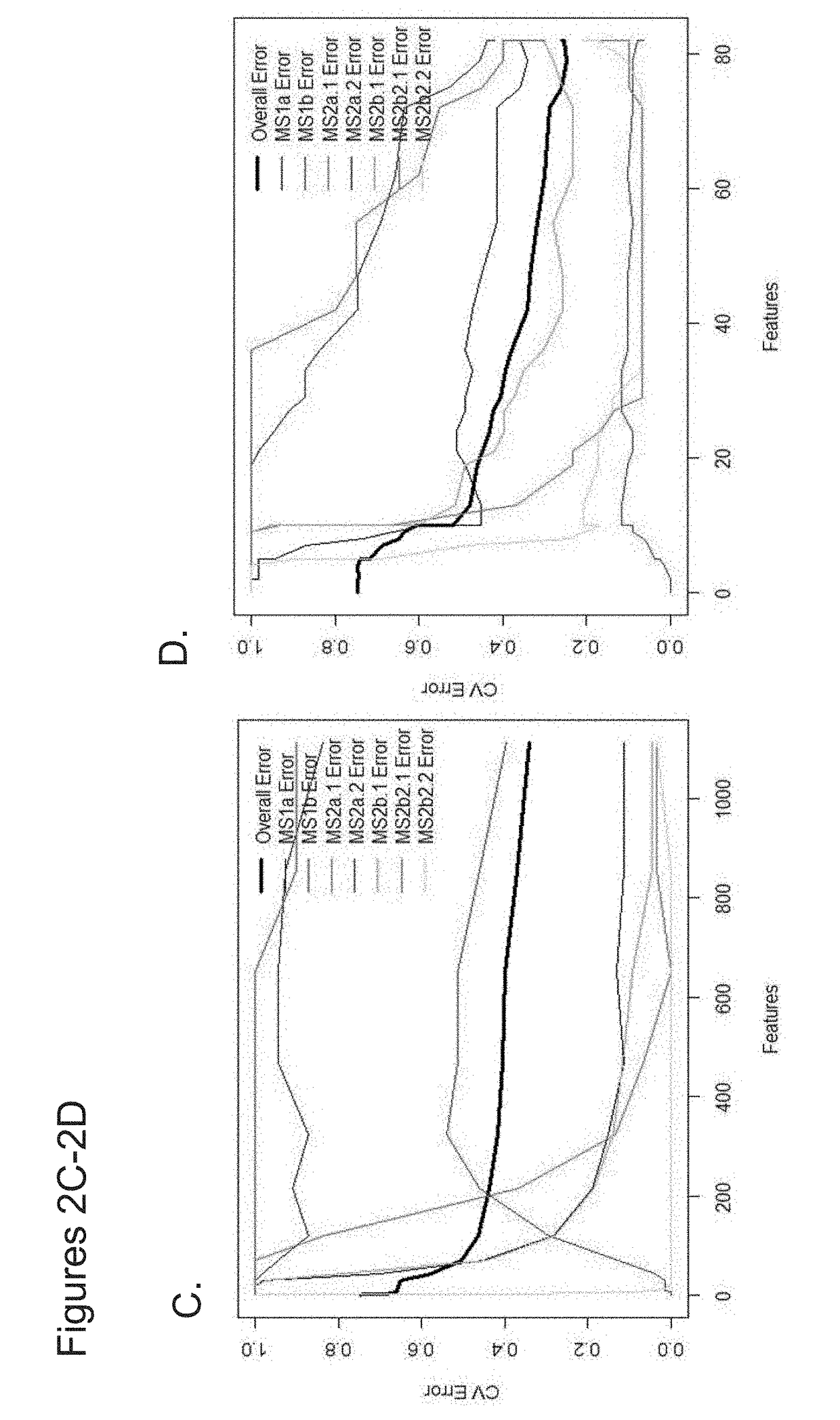Therapeutic, diagnostic, and prognostic methods for cancer
- Summary
- Abstract
- Description
- Claims
- Application Information
AI Technical Summary
Benefits of technology
Problems solved by technology
Method used
Image
Examples
example 1
Materials and Methods
[0285]Tumor Samples
[0286]A collection of 204 formalin-fixed paraffin-embedded (FFPE) bladder cancer tumor samples were obtained from Cureline, Inc. (South San Francisco, Calif.) following approval of the Ethics Committee of Saint Petersburg City Clinical Oncology Hospital and appropriate confirmation of written informed consent, or from The MT Group (Van Nuys, Calif.) following Institutional Review Board approval (Sterling Institutional Review Board). The clinical samples faithfully recapitulated the expected ˜80% / 20% male / female ratio that is typically observed in bladder cancer, and the proportions of non-muscle-invasive bladder cancers (NMIBCs: T0, T1), muscle-invasive bladder cancers (MIBCs; T2, T3) and metastases were ˜75% and ˜25%, respectively (FIG. 1), consistent with the clinical incidence of these stages in the bladder cancer population (Jemal et al, CA Cancer J. Clin, 61(2): 69-90, 2011; Heney, Ural. Clin. North Am, 19(3): 429-433, 1992; Hall et al. U...
example 2
Development of a Custom Microfluidics-Based Bladder Cancer Gene Expression Panel and its Application in Stratifying Archival Bladder Cancer Clinical Samples
[0300]While genomic analyses have provided valuable insights into the molecular underpinnings of bladder cancer, the majority of previous studies rely on the use of frozen tissues that yield high-quality nucleic acids and are generally not well-suited for characterization of archival specimens from clinical trials. However, archival specimens from clinical trials are often associated with accompanying treatment information, disease-free survival (DFS) and overall survival (OS) information, and other information that makes them an excellent platform for cancer genomic analysis. Here we developed a microfluidics-based bladder cancer gene expression panel that is optimized for the analysis of formalin-fixed, paraffin-embedded tissues. The custom bladder cancer Fluidigm panel is comprised of 96 genes that were selected to capture key...
example 3
FGFR3 is Hyper-Mutated and Overexpressed in Rapidly-Recurrent NMIBCs, and High Expression in a Subset of Invasive and Metastatic Tumors is Associated with Poor Clinical Outcomes
[0309]One of the characteristic features of NMIBCs is that they carry somatic activating mutations in Fibroblast Growth Factor Receptor 3 (FGFR3) in approximately 60-70% of cases (van Rhijn et al. J. Pathol. 198(2): 245-251; Tomlinson et al. J. Pathol. 213(1): 91-98, 2007; Martinez-Torrecuadrada et al. Clin. Cancer Res. 11(17): 6280-6290, 2005; Kompier et al. PLoS One 5(11): e13821, 2010; Juanpere et al. Hum. Pathol. 43(10): 1573-1582, 2012; Gust et al. Mol. Cancer Ther 12(7): 1245-1254, 2013; Cappellen et al, Nat. Genet, 23(1): 18-20, 1999; Ah-Ahmadie et al. J. Pathol. 224(2): 270-279, 2011). The majority of FGFR3 mutations are missense substitutions in the extracellular or juxtamembrane domains that lead to ligand-independent receptor dimerization and subsequent activation (Tomlinson et al. supra; Cappellen...
PUM
| Property | Measurement | Unit |
|---|---|---|
| Volume | aaaaa | aaaaa |
| Volume | aaaaa | aaaaa |
| Volume | aaaaa | aaaaa |
Abstract
Description
Claims
Application Information
 Login to View More
Login to View More - R&D
- Intellectual Property
- Life Sciences
- Materials
- Tech Scout
- Unparalleled Data Quality
- Higher Quality Content
- 60% Fewer Hallucinations
Browse by: Latest US Patents, China's latest patents, Technical Efficacy Thesaurus, Application Domain, Technology Topic, Popular Technical Reports.
© 2025 PatSnap. All rights reserved.Legal|Privacy policy|Modern Slavery Act Transparency Statement|Sitemap|About US| Contact US: help@patsnap.com



